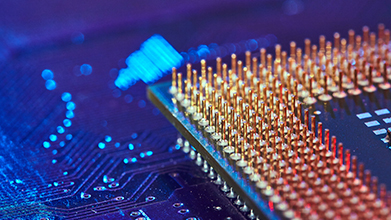Cloud native EDA tools & pre-optimized hardware platforms
Embedded flash and its off-chip counterpart, NOR flash, have been the gold standards for non-volatile memory — the kind used for persistent or long-term data storage — for many years. But these memory stalwarts are struggling to support process technologies that have shrunk below 28nm. And they were never designed for AI, IoT, and other applications that demand lightning-fast data collection, transmission, storage, and analysis at scale.
To address the need for better non-volatile memory, two emerging technologies have come to the forefront: Magneto-Resistive Random Access Memory (MRAM) and Resistive Random Access Memory (RRAM). Not only do these embedded memories provide the density, capacity, and scalability for modern processing requirements, they’re also optimized for different applications, use cases, and needs.

MRAM: Highest reliability and performance
From AI in the core to edge devices connected through the cloud, different applications have unique memory requirements. MRAM and RRAM offer distinctive traits and trade-offs — spanning reliability, density, performance, and cost — providing choice and optimization for a variety of use cases.
MRAM, for example, delivers higher reliability and superior power, performance, and area (PPA), even in extreme environments. Initially developed for aerospace applications, it uses an adjustable magnetic layer to maximize storage density. And its exceptional power and performance characteristics are ideal for applications requiring the highest levels of reliability and data integrity.
MRAM is well-suited for modern vehicles that need over-the-air (OTA) software updates, for instance. It can also help reduce the power consumption of advanced microcontrollers (MCUs) and AI accelerators without compromising performance.
Despite its reliability in extreme conditions, MRAM is sensitive to strong magnetic fields. Mitigation measures, including physical placement constraints or shielding, may be needed in certain environments.
RRAM: Lowest cost and highest density
While MRAM has already become a popular alternative to traditional embedded flash memory, RRAM is still in the early stages of market awareness and adoption. Using a dielectric layer to store data, it isn’t sensitive to magnetic fields like MRAM but is less reliable in extreme environments and conditions.
Low cost and energy consumption combined with high density and scalability make RRAM an ideal choice for IoT devices, wearables, in-room sensors, and other applications requiring cost, power, and space efficiency. RRAM is also being used in automotive applications where environmental conditions are benign or mitigated.
Regardless of application or use case, both MRAM and RRAM provide superior density, power efficiency, scalability, and performance compared to legacy embedded memory technologies.
Streamlining MRAM and RRAM development with flexible, IP-based compilers
Synopsys provides IP-based compiler solutions that streamline MRAM and RRAM integration. While other providers only offer a limited set of fixed-macro options, our compilers are comprehensive and configurable, enabling developers to instantly build a wide range of macros and precisely match memory sizes and aspect ratios with MCU requirements.
Our MRAM Compiler, for example, supports higher memory capacity (up to 128Mb), smaller footprint, and more configurations (including multiple bits-per-word and word width, aspect ratio, and floorplan optimizations) than alternative IP solutions. Features like write-verify-write and read-modify-write improve performance and reduce power consumption. And configurable memory-macro generation allows developers to optimize the configuration for their application, resulting in PPA advantages of >10%.
Our MRAM Compiler is well-suited for newer applications with simplified power supply requirements, built-in self-test (BIST) and repair, and error correction code (ECC). In addition to accelerating system-on-chip (SoC) integration and time-to-market, it addresses the growing demand for reliable, cost-effective, efficient memory in AI-enabled applications.
We have been actively working with MRAM in TSMC 22ULL and TSMC 16FFC processes. We are developing automotive MRAM and RRAM compilers in the GF 22FDX process. And we have demonstrated successful MRAM silicon on the 22ULL process, enabling SoC designers with low-risk solutions for their target applications. Data retention, write endurance, and magnetic immunity testing results have met or exceeded design targets.
Redefining the future of embedded memory and applications
Overcoming the limitations of legacy memory solutions, MRAM and RRAM are enabling innovation across a wide range of applications, including automotive systems, IoT devices, and AI accelerators. With seamless on-chip integration, low power consumption, and extremely high density, they are a perfect fit for today’s and tomorrow’s computational needs.
Leading foundries have announced roadmaps for additional MRAM and RRAM enablement, including fin field-effect transistor (FinFET) solutions reaching 6nm and beyond. And we will continue advancing next-gen memory technologies and helping redefine the future of embedded systems.










